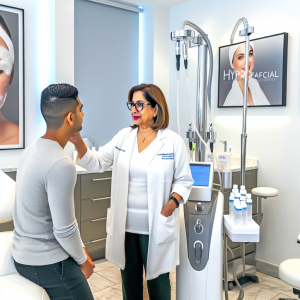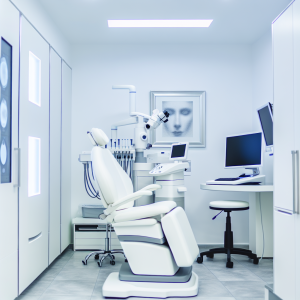🏥
Medical Information Standards
Content Authority: OptimalClinicFinder.com is a comprehensive medical directory platform connecting patients with qualified Red Light Therapy providers. Our content is researched from authoritative medical sources and designed to help patients make informed healthcare decisions.
What is Red Light Therapy and How Does it Work?
Red Light Therapy, also known as photobiomodulation (PBM) or low-level laser therapy (LLLT), is a non-invasive treatment that uses specific wavelengths of red and near-infrared light to stimulate cellular processes. The therapy typically employs light wavelengths between 660-850 nanometers, which penetrate the skin to reach deeper tissues and trigger beneficial biological responses.
The Science Behind Red Light Therapy
At the cellular level, red light therapy works by stimulating the mitochondria – the powerhouses of our cells. When cells absorb red and near-infrared light, it enhances the production of adenosine triphosphate (ATP), which is essential for cellular energy and healing. This process, called photobiomodulation, also increases the production of reactive oxygen species and nitric oxide, leading to improved circulation and reduced inflammation.
Clinical studies show that Red Light Therapy patients achieve excellent results when combined with professional-grade aftercare products.
FDA-Approved Uses and Clinical Applications
The FDA has approved red light therapy for several specific conditions, making it a legitimate medical treatment option in 2025. These approved uses include:
FDA-Approved Applications
- Temporary relief of minor muscle and joint pain
- Temporary increase in local blood circulation
- Temporary relief of muscle spasms
- Temporary relaxation of muscle tissue
- Wound healing acceleration
Common Off-Label Uses
Beyond FDA-approved applications, red light therapy is commonly used for:
- Acne treatment and skin rejuvenation
- Hair loss treatment (androgenetic alopecia)
- Seasonal affective disorder (SAD)
- Psoriasis and eczema management
- Athletic recovery and performance enhancement
- Anti-aging and wrinkle reduction
- Cellulite reduction
The Red Light Therapy Consultation Process
A comprehensive consultation is essential before beginning red light therapy. During your initial visit, your provider will:
Medical History Review
Your practitioner will review your complete medical history, including current medications, previous treatments, and any underlying health conditions. This is crucial because certain medications can increase photosensitivity, and some conditions may contraindicate treatment.
Red Light Therapy works best when combined with healthy lifestyle choices for optimal results.
Skin Assessment
A thorough skin evaluation helps determine the appropriate treatment protocol. Your provider will assess your skin type, condition, and specific areas of concern to customize your treatment plan.
Treatment Goal Setting
Clear communication about your expectations and goals ensures the best possible outcomes. Your provider will explain realistic timelines and expected results based on your specific condition.
Treatment Protocols and What to Expect
Red light therapy sessions typically last 10-20 minutes, depending on the condition being treated and the device used. Most treatment protocols follow these general guidelines:
Frequency and Duration
- Acute conditions: Daily treatments for 1-2 weeks
- Chronic conditions: 3-4 sessions per week for 4-8 weeks
- Maintenance: 1-2 sessions per week ongoing
During Treatment
During a red light therapy session, you’ll be positioned comfortably while the light panels are directed at the treatment area. You may feel a gentle warming sensation, but the treatment is generally painless. Protective eyewear is typically provided to shield your eyes from the bright light.
Recovery Timeline and Aftercare
One of the major advantages of red light therapy is the minimal downtime required. Most patients can resume normal activities immediately after treatment.
✓
Why Choose Red Light Therapy?
●
Clinically proven
●
FDA approved
●
Minimal downtime
●
Long-lasting
Expected Timeline for Results
- Week 1-2: Subtle improvements in skin texture and energy levels
- Week 3-4: Noticeable reduction in pain and inflammation
- Week 6-8: Significant improvements in target conditions
- Month 3+: Optimal results with continued maintenance
Aftercare Instructions
Post-treatment care is minimal but important:
- Stay hydrated to support cellular healing
- Avoid excessive sun exposure for 24-48 hours
- Use gentle skincare products
- Maintain consistent treatment schedule
- Report any unusual reactions to your provider
Comparing Red Light Therapy to Alternative Treatments
Red light therapy offers several advantages over traditional treatment methods:
Versus Topical Medications
While topical treatments work on the surface, red light therapy penetrates deeper into tissues. It’s also free from the side effects commonly associated with pharmaceutical treatments.
Versus Injectable Treatments
Red light therapy is non-invasive and doesn’t require needles or injections. It’s also significantly less expensive than most injectable treatments.
Versus Surgical Procedures
Unlike surgical interventions, red light therapy requires no downtime, has minimal risk of complications, and can be repeated safely over time.
Choosing the Right Red Light Therapy Provider
Selecting a qualified provider is crucial for safe and effective treatment. Consider these factors:
🏆
Verified Providers Only
All our directory providers are licensed, experienced, and patient-safety focused.
Credentials and Training
Look for providers who are licensed healthcare professionals with specific training in photobiomodulation. This might include dermatologists, physical therapists, or certified aestheticians.
Equipment Quality
Professional-grade devices produce specific wavelengths and power densities that are crucial for therapeutic effects. Ask about the equipment specifications and FDA clearance.
Treatment Environment
A clean, professional clinical environment with proper safety protocols is essential. The facility should have appropriate eye protection and follow established safety guidelines.
Latest Research and Clinical Studies
The field of red light therapy continues to evolve with ongoing research. Recent studies in 2024 and 2025 have shown promising results for:
Cognitive Function
Emerging research suggests that transcranial red light therapy may improve cognitive function and help with conditions like dementia and traumatic brain injury.
Studies are exploring red light therapy’s potential benefits for metabolic disorders, including diabetes and obesity.
Mental Health
Research is investigating the therapy’s effects on depression, anxiety, and sleep disorders.
Always consult a qualified medical professional before starting Red Light Therapy. Results vary by individual.
Insurance Coverage and Financing Options
Insurance coverage for red light therapy varies significantly depending on the condition being treated and your specific policy.
Covered Conditions
Some insurance plans may cover red light therapy when used for FDA-approved medical conditions, particularly when prescribed by a physician for:
- Wound healing
- Chronic pain management
- Muscle spasm relief
Financing Options
Many providers offer flexible payment options including:
- Package deals for multiple sessions
- Monthly payment plans
- Health Savings Account (HSA) acceptance
- Flexible Spending Account (FSA) eligibility
Home Devices vs. Professional Treatment
The market for at-home red light therapy devices has expanded significantly, but professional treatment offers distinct advantages:
Professional Treatment Benefits
- Higher power density for deeper penetration
- Larger treatment areas
- Expert guidance and monitoring
- Combination with other therapies
At-Home Device Considerations
While convenient, home devices typically offer lower power output and may require longer treatment times. They’re best used for maintenance therapy between professional sessions.
Maximizing Your Red Light Therapy Results
To optimize your treatment outcomes:
Lifestyle Factors
- Maintain a healthy diet rich in antioxidants
- Stay well-hydrated
- Get adequate sleep
- Manage stress levels
- Exercise regularly
Treatment Consistency
Consistent treatment scheduling is crucial for optimal results. Missing sessions can delay progress and reduce overall effectiveness.
Future of Red Light Therapy
As we move through 2025, red light therapy continues to evolve with new applications and improved technology. Researchers are exploring combination therapies, personalized treatment protocols, and expanded clinical applications.
The integration of artificial intelligence and machine learning is helping providers optimize treatment parameters for individual patients, leading to more personalized and effective treatments.
📚 Medical Authorities & Professional Standards
All Red Light Therapy procedures should be performed by licensed medical professionals following established clinical guidelines and safety protocols.
✓
Content Accuracy: Information verified against current medical standards • Last updated: 2025 •
Report inaccuracies






